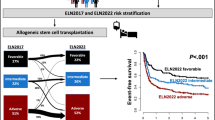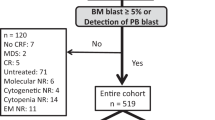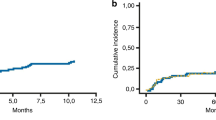Abstract
Recently a new three-group clinical classification was reported by an International Consortium to stratify CMML patients with regard to prognosis. The groups were defined as follows: (1) Myelodysplastic (MD)-CMML: WBC ≤ 10 × 109/l, circulating immature myeloid cells (IMC) = 0, no splenomegaly; (2) MD/MP (overlap)–CMML: WBC 10–20 × 109/l or WBC ≤ 10 × 109/l but IMC > 0 and/or splenomegaly; (3) Myeloproliferative (MP)-CMML: WBC > 20 × 109/l. By analysing EBMT Registry patients who underwent allo-HCT for CMML between 1997 and 2016, we aimed to determine the impact of this classification on transplantation outcome and to make a comparison with the conventional WHO classification (CMML-0/CMML-1/CMML-2). Patient grouping was based on the data registered at time of transplantation, with IMC replaced by peripheral blasts. Among 151 patients included in the analysis, 38% were classified as MD-CMML, 42% as MD/MP-CMML and 20% as MP-CMML. With a median survival of 17 months in the whole series, MD-CMML patients were distinguished as a low-risk group with higher CR rate at transplant and a longer post-transplant 2-year progression-free survival in comparison to others (44.5% vs 33.5%, respectively), whereas the WHO classification was superior in identifying high-risk patients (CMML-2) with inferior survival outcomes.
This is a preview of subscription content, access via your institution
Access options
Subscribe to this journal
Receive 12 print issues and online access
$259.00 per year
only $21.58 per issue
Buy this article
- Purchase on Springer Link
- Instant access to full article PDF
Prices may be subject to local taxes which are calculated during checkout


Similar content being viewed by others
References
Bennett JM, Catovsky D, Daniel MT, Flandrin G, Galton DA, Gralnick HR, et al. Proposals for the classification of the myelodysplastic syndromes. Br J Haematol. 1982;51:189–99.
Bennett JM, Catovsky D, Daniel MT, Flandrin G, Galton DA, Gralnick H, et al. The chronic myeloid leukaemias: guidelines for distinguishing chronic granulocytic, atypical chronic myeloid, and chronic myelomonocytic leukaemia. Proposals by the French-American-British Cooperative Leukaemia Group. Br J Haematol. 1994;87:746–54.
Voglová J, Chrobák L, Neuwirtová R, Malasková V, Straka L. Myelodysplastic and myeloproliferative type of chronic myelomonocytic leukemia—distinct subgroups or two stages of the same disease? Leuk Res. 2001. https://doi.org/10.1016/S0145-2126(00)00159-4.
Onida F, Kantarjian HM, Ball G, Estey E, Keating MJ, Glassmann A, et al. The dysplastic versus proliferative classification dilemma of chronic myelomonocytic leukemia: a retrospective single institution analysis of 273 patients. Blood. 2001;98:2607.
Vardiman JW, Harris NL, Brunning RD. The World Health Organization (WHO) classification of the myeloid neoplasms. Blood. 2002;100:2292–302.
Arber DA, Orazi A, Hasserjian R, Thiele J, Borowitz MJ, Le Beau MM, et al. The 2016 revision to the World Health Organization (WHO) classification of myeloid neoplasms and acute leukemia. Blood. 2016;127:2391–405.
Cervera N, Itzykson R, Coppin E, Prebet T, Murati A, Legall S, et al. Gene mutations differently impact the prognosis of the myelodysplastic and myeloproliferative classes of chronic myelomonocytic leukemia. Am J Hematol. 2014;89:604–9.
Ricci C, Fermo E, Corti S, Molteni M, Faricciotti A, Cortelezzi A, et al. RAS mutations contribute to evolution of chronic myelomonocytic leukemia to the proliferative variant. Clin Cancer Res. 2010. https://doi.org/10.1158/1078-0432.CCR-09-2112.
Itzykson R, Duchmann M, Lucas N, Solary E. CMML: clinical and molecular aspects. Int J Hematol. 2017. https://doi.org/10.1007/s12185-017-2243-z.
Onida F. Models of prognostication in chronic myelomonocytic leukemia. Curr Hematol Malig Rep. 2017. https://doi.org/10.1007/s11899-017-0416-8.
Padron E, Garcia-Manero G, Patnaik MM, Itzykson R, Lasho T, Nazha A, et al. An international data set for CMML validates prognostic scoring systems and demonstrates a need for novel prognostication strategies. Blood Cancer J. 2015;5:e333.
Itzykson R, Kosmider O, Renneville A, Gelsi-Boyer V, Meggendorfer M, Morabito M, et al. Prognostic score including gene mutations in chronic myelomonocytic leukemia. J Clin Oncol. 2013;31:2428–36.
Patnaik M, Itzykson R, Lasho T, Kosmider O, Finke C, Hanson C, et al. ASXL1 and SETBP1 mutations and their prognostic contribution in chronic myelomonocytic leukemia: a two-center study of 466 patients. Leukemia. 2014;28:2206–12.
Elena C, Gall A, Such E, Meggendorfer M, Germing U, Rizzo E, et al. Integrating clinical features and genetic lesions in the risk assessment of patients with chronic myelomonocytic leukemia. Blood. 2016;128:1408–18.
Patnaik MM, Padron E, LaBorde RR, Lasho TL, Finke CM, Hanson CA, et al. Mayo prognostic model for WHO-defined chronic myelomonocytic leukemia: ASXL1 and spliceosome component mutations and outcomes. Leukemia. 2013;27:1504–10.
Woo J, Choi DR, Storer BE, Yeung C, Halpern AB, Salit RB, et al. Impact of clinical, cytogenetic, and molecular profiles on long-term survival after transplantation in patients with chronic myelomonocytic leukemia. Haematologica. 2020. https://doi.org/10.3324/haematol.2019.218677.
Gagelmann N, Badbaran A, Beelen DW, Salit RB, Stölzel F, Rautenberg C, et al. A prognostic score including mutation profile and clinical features for patients with CMML undergoing stem cell transplantation. Blood Adv. 2021;5. https://doi.org/10.1182/bloodadvances.2020003600.
Itzykson R, Fenaux P, Bowen D, Cross N, Cortes J, De Witte T, et al. Diagnosis and treatment of chronic myelomonocytic leukemias in adults: recommendations from the European Hematology Association and the European LeukemiaNet. HemaSphere. 2018. https://doi.org/10.1097/HS9.0000000000000150.
Valent P, Orazi A, Savona MR, Patnaik MM, Onida F, Van De Loosdrecht AA, et al. Proposed diagnostic criteria for classical chronic myelomonocytic leukemia (CMML), CMML variants and pre-CMML conditions. Haematologica. 2019. https://doi.org/10.3324/haematol.2019.222059.
Onida F, Iacobelli S, Garcia-Manero G, Patnaik MM, Itzykson R, Lasho TL, et al. A new clinically-based subclassification proposal in CMML with significant prognostic implications to overcome the MDS/MPN categorizing dilemma. Blood. 2016. https://doi.org/10.1182/blood.v128.22.4320.4320.
Rautenberg C, Schuler E, Nachtkamp K, Schroeder T, Blum S, Aul C, et al. Validation of a new clinically based classification system for stratification of prognosis in patients with CMML. Leuk Res. 2017 https://doi.org/10.1016/s0145-2126(17)30372-7.
Symeonidis A, Van Biezen A, de Wreede L, Piciocchi A, Finke J, Beelen D, et al. Achievement of complete remission predicts outcome of allogeneic haematopoietic stem cell transplantation in patients with chronic myelomonocytic leukaemia. A study of the Chronic Malignancies Working Party of the European Group for Blood and Marrow Trans. Br J Haematol. 2015. https://doi.org/10.1111/bjh.13576.
Author information
Authors and Affiliations
Contributions
FO wrote the manuscript, designed the study, and interpreted the data. GS and SI designed the study, performed the statistical analyses, interpreted the data, and edited the manuscript. LK provided EBMT Registry Data. MR, PH, and IYA designed the study, interpreted the data, and edited the manuscript. AR, KS, NK, JS, GS, JC, XP, LR, JHB, JF, JP, US, HCS, YB, SM, ED, AG, SZ, BL, and RR reviewed the manuscript and provided clinical data. All authors approved the final version of the manuscript.
Corresponding author
Ethics declarations
Competing interests
The authors declare no competing interests.
Ethical approval
The current study has been approved by the scientific board of the CMWP of the EBMT.
Additional information
Publisher’s note Springer Nature remains neutral with regard to jurisdictional claims in published maps and institutional affiliations.
Rights and permissions
About this article
Cite this article
Onida, F., Sbianchi, G., Radujkovic, A. et al. Prognostic value of a new clinically-based classification system in patients with CMML undergoing allogeneic HCT: a retrospective analysis of the EBMT-CMWP. Bone Marrow Transplant 57, 896–902 (2022). https://doi.org/10.1038/s41409-021-01555-9
Received:
Revised:
Accepted:
Published:
Issue Date:
DOI: https://doi.org/10.1038/s41409-021-01555-9



